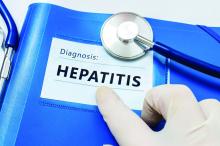If you work on the front lines of medical care treating patients with hepatitis, you may not have time to review all the hepatitis research that enters the medical literature every month. Here’s a quick look at some notable news items and journal articles published over the past month, covering a variety of the major hepatitis viruses.
The overall incidence of occult hepatitis B infection (OBI) and window period (WP) infections was found to be low – at 1 in 6,503 and 1 in 24,214 donations respectively – during a study of transfusion associated HBV infection in India.
The prevalence of the hepatitis delta virus 3 (HDV-3) was confirmed in the Amazon region of Brazil, without intergenotypic recombination, according to a study in BMC Infectious Diseases.A Korean study found tenofovir disoproxil fumarate (TDF) mono–rescue therapy to be a reasonable option in chronic hepatitis B virus patients with lamivudine resistance and entecavir resistance. However, the authors said combination therapy should be considered in patients with high baseline HBV DNA levels.
The Hepavax-Gene TF vaccine was equally effective and non-inferior to the Engerix-B vaccine in terms of prevention of mother-to-child hepatitis B virus transmission in neonates born to mothers positive for HBsAg, according to a study in the Pediatric Infectious Disease Journal.
Interferon alfa (IFN-alfa)–based antiviral therapy of hepatitis delta virus infection was independently associated with a lower likelihood for clinical disease progression, according to a German study.
A study of hepatitis C–infected patients in Australian prisons found that bonding and linking social capital can be valuable resources in promoting HCV treatment awareness, uptake, and adherence, and that peer-based programs are likely to be influential in promoting HCV outcomes in the prison setting.
An analysis in Hepatology found that hepatitis C virus testing interventions resulted in an increase in birth cohort testing, compared with standard of care, but also increased costs, although the results support more widespread adoption of BC testing, compared with the other interventions.
A health education program at substance dependence treatment centers in Portugal improved significantly patient knowledge about hepatitis C, even among patients with high baseline knowledge, and increased the rate of referral to liver specialists.
A single-center trial of direct-acting antivirals in treatment-naive patients with chronic hepatitis C virus genotype (GT)1 or 3 infection supported the use of 8-week DAA treatment regimens that maintain high efficacy, even for patients infected with HCV GT3 infection.
Results from the OSIRIS study revealed that simeprevir plus sofosbuvir for 12 weeks achieved a 100% sustained virologic response rate in hepatitis C virus genotype 4-infected patients with or without compensated cirrhosis.
A literature review found that the polymorphism interferon-lambda 4 (IFNL4) ss469415590 was significantly associated with sustained virologic response in hepatitis C virus genotype 1-infected patients, irrespective of race, and has a tendency to be associated with HCV GT2/3 patients.
The overall incidence of occult hepatitis B infection and window period infections was found to be low at 1 in 6,503 and 1 in 24,214 donations, respectively, in a study of South Indian blood donors.
The introduction of universal mass vaccination against hepatitis A in countries with intermediate endemicity for HAV infection led to a considerable decrease in the incidence of hepatitis A in vaccinated and in non-vaccinated age groups alike.
A systematic review in the Journal of Viral Hepatitis found a higher incidence of hepatitis C virus in women, compared with men who inject drugs.
A recent study found that treatment for 6 weeks with ledipasvir plus sofosbuvir was well tolerated and highly effective in patients with acute hepatitis C virus genotype 1 monoinfection.
A Spanish study found that response-guided therapy with boceprevir in combination with pegylated interferon-alfa 2a/ribavirin for HCV-HIV coinfected patients led to overall sustained virologic response rates of 67% but only 51% in patients with cirrhosis.
On Twitter @richpizzi


